Characterization of a Topramezone-Resistant Rice Mutant TZR1: Insights into GST-Mediated Detoxification and Antioxidant Responses
Abstract
1. Introduction
2. Results
2.1. Dose-Response of CY9H and TZR1 to Topramezone
2.2. Sequence Analysis and Expression Levels of OsHPPD mRNA
2.3. Effects of CYP450 and GST Inhibitors on the Resistance of TZR1 to Topramezone
2.4. Whole-Genome Resequencing Analysis
2.5. Analysis of DEGs by RNA-Seq
2.6. Verification of the DEGs by RT-qPCR Assay
2.7. GST Activity
2.8. Activity of Redox-Related Enzymes H2O2
3. Discussion
4. Materials and Methods
4.1. Rice Line, Herbicide, and Chemicals
4.2. Plant Materials and Growth Conditions
4.3. Topramezone Dose-Response Assay
4.4. Sequencing of the OsHPPD Gene
4.5. Determination of OsHPPD Gene Expression
4.6. Effects of CYP450 and GST Inhibitors on Topramezone Resistance
4.7. Whole-Genome Resequencing of CY9H and TZR1
4.8. Transcriptome Sequencing
4.9. RT-qPCR Validation of Differentially Expressed Genes
4.10. Measurement of Enzymatic Activity
4.11. Data Analysis
5. Conclusions
Supplementary Materials
Author Contributions
Funding
Data Availability Statement
Acknowledgments
Conflicts of Interest
Abbreviations
| CY9H | Chuangyu 9H |
| HPPD | 4-hydroxyphenylpyruvate dioxygenase |
| TSR | Target-site resistance |
| NTSR | Non-target-site resistance |
| CYP450s | Cytochrome P450 monooxygenases |
| GSTs | Glutathione S-transferases |
| UGTs | UDP-glycosyltransferases |
| ABC | ATP-binding cassett |
| EMS | Ethyl methanesulfonate |
| RT-qPCR | Real-time quantitative PCR |
| WGS | Whole-genome resequencing |
| DEGs | Differentially expressed genes |
| RNA-seq | Transcriptome sequencing |
| GR50 | The herbicide dose for a growth reduction by 50% |
| RI | Resistance index |
| NBD-Cl | 4-chloro-7-nitrobenzoxadiazole |
| GO | Gene Ontology |
| DGs | Differential genes |
| KEGG | Kyoto Encyclopedia of Genes and Genomes |
| MDA | Malondialdehyde |
| H2O2 | Hydrogen peroxide |
| CAT | Catalase |
| SOD | Superoxide dismutase |
| MoA | Mode of action |
| GSH | Glutathione |
| ROS | Reactive oxygen species |
| FC | Fold change |
| FPKM | Fragments Per Kilobase of transcript per Million fragments mapped |
| FDR | False discovery rate |
| CL | Confidence limits |
References
- Xia, J.Q.; Liang, Q.Y.; He, D.Y.; Zhang, Z.Y.; Wu, J.; Zhang, J.; Zhao, P.X.; Zhang, Z.S.; Xia, C.B. Knockout of OsSPL10 confers enhanced glufosinate resistance in rice. Plant Commun. 2024, 5, 100731. [Google Scholar] [CrossRef]
- Hernández-Soto, A.; Echeverría-Beirute, F.; Abdelnour-Esquivel, A.; Valdez-Melara, M.; Boch, J.; Gatica-Arias, A. Rice breeding in the new era: Comparison of useful agronomic traits. Curr. Plant Biol. 2021, 27, 100211. [Google Scholar] [CrossRef]
- Zhang, C.; Zhong, X.; Li, S.; Yan, L.; Li, J.; He, Y.; Lin, Y.; Zhang, Y.Z.; Xia, L.Q. Artificial evolution of OsEPSPS through an improved dual cytosine and adenine base editor generated a novel allele conferring rice glyphosate tolerance. J. Integr. Plant Biol. 2023, 65, 2194–2203. [Google Scholar] [CrossRef] [PubMed]
- Han, B.; Ma, X.; Cui, D.; Wang, Y.; Geng, L.; Cao, G.; Zhang, H.; Han, L. Comprehensive evaluation and analysis of the mechanism of cold tolerance based on the transcriptome of weedy rice seedlings. Rice 2020, 13, 12. [Google Scholar] [CrossRef]
- Wu, Y.; Xiao, N.; Cai, Y.; Yang, Q.; Yu, L.; Chen, Z.; Shi, W.; Liu, J.; Pan, C.; Li, Y.; et al. CRISPR-Cas9-mediated editing of the OsHPPD 3′ UTR confers enhanced resistance to HPPD-inhibiting herbicides in rice. Plant Commun. 2023, 4, 100605. [Google Scholar] [CrossRef]
- Sudianto, E.; Beng-Kah, S.; Ting-Xiang, N.; Saldain, N.E.; Scott, R.C.; Burgos, N.R. Clearfield rice: Its development, success, and key challenges on a global perspective. Crop Prot. 2013, 49, 40–51. [Google Scholar] [CrossRef]
- Kim, S.E.; Bian, X.; Lee, C.J.; Park, S.U.; Lim, Y.H.; Kim, B.H.; Park, W.S.; Ahn, M.J.; Ji, C.Y.; Yu, Y.; et al. Overexpression of 4-hydroxyphenylpyruvate dioxygenase (IbHPPD) increases abiotic stress tolerance in transgenic sweetpotato plants. Plant Physiol. Biochem. 2021, 167, 420–429. [Google Scholar] [CrossRef] [PubMed]
- Powles, S.B.; Yu, Q. Evolution in action: Plants resistant to herbicides. Annu. Rev. Plant Biol. 2010, 61, 317–347. [Google Scholar] [CrossRef] [PubMed]
- Gaines, T.A.; Duke, S.O.; Morran, S.; Rigon, C.A.; Tranel, P.J.; Küpper, A.; Dayan, F.E. Mechanisms of evolved herbicide resistance. J. Biol. Chem. 2020, 295, 10307–10330. [Google Scholar] [CrossRef] [PubMed]
- Siehl, D.L.; Tao, Y.; Albert, H.; Dong, Y.; Heckert, M.; Madrigal, A.; Lincoln-Cabatu, B.; Lu, J.; Fenwick, T.; Bermudez, E.; et al. Broad 4-hydroxyphenylpyr-uvate dioxygenase inhibitor herbicide tolerance in soybean with an optimized enzyme and expression cassette. Plant Physiol. 2014, 166, 1162–1176. [Google Scholar] [CrossRef] [PubMed]
- Liang, Y.; Minami, H.; Sato, F. Isolation of herbicide-resistant 4-hydroxyphenylpyruvate dioxygenase from cultured Coptis japonica cells. Biosci. Biotech. Biochem. 2008, 72, 3059–3062. [Google Scholar] [CrossRef] [PubMed][Green Version]
- Liu, B.; Wang, H.; Zhang, K.; Zhu, J.; He, Q.; He, J. Improved herbicide resistance of 4-hydroxyphenylpyruvate dioxygenase from Sphingobium sp. TPM-19 through directed evolution. J. Agric Food Chem. 2020, 68, 12365–12374. [Google Scholar] [CrossRef] [PubMed]
- Wang, H.; Lei, P.; Liu, B.; Zhu, J.; He, Q.; Chen, L.; He, J. Mutations of Asn321 and Glu322 Improve Resistance of 4-Hydroxyphenylpyruvate Dioxygenase SpHPPDm to Topramezone. J. Agric. Food Chem. 2022, 70, 9703–9710. [Google Scholar] [CrossRef]
- Délye, C.; Jasieniuk, M.; Le Corre, V. Deciphering the evolution of herbicide resistance in weeds. Trends Genet. 2013, 29, 649–658. [Google Scholar] [CrossRef] [PubMed]
- Yu, Q.; Powles, S. Metabolism-based herbicide resistance and cross-resistance in crop weeds: A threat to herbicide sustainability and global crop production. Plant Physiol. 2014, 166, 1106–1118. [Google Scholar] [CrossRef] [PubMed]
- Ju, B.; Liu, M.; Fang, Y.; Liu, L.; Pan, L. First report on resistance to HPPD herbicides mediated by nontarget-site mechanisms in the grass Leptochloa chinensis. J. Agric. Food Chem. 2023, 71, 17669–17677. [Google Scholar] [CrossRef]
- Zhang, J.J.; Yang, H. Metabolism and detoxification of pesticides in plants. Sci. Total Environ. 2021, 790, 148034. [Google Scholar] [CrossRef] [PubMed]
- Lan, Y.; Cao, Y.; Sun, Y.; Wang, R.; Huang, Z. Enhancing the tolerance of a green foxtail biotype to mesotrione via a cytochrome P450-mediated herbicide metabolism. Agronomy 2024, 14, 2399. [Google Scholar] [CrossRef]
- Heap, I. The International Survey of Herbicide Resistant Weeds. Available online: https://www.weedscience.org (accessed on 6 December 2024).
- Nakka, S.; Godar, A.S.; Wani, P.S.; Thompson, C.R.; Peterson, D.E.; Roelofs, J.; Jugulam, M. Physiological and molecular characterization of hydroxyphenylpyruvate dioxygenase (HPPD)-inhibitor resistance in Palmer amaranth (Amaranthus palmeri S. Wats.). Front. Plant Sci. 2017, 8, 555. [Google Scholar] [CrossRef]
- Hausman, N.E.; Singh, S.; Tranel, P.J.; Riechers, D.E.; Kaundun, S.S.; Polge, N.D.; Thomas, D.A.; Hager, A.G. Resistance to HPPD-inhibiting herbicides in a population of waterhemp (Amaranthus tuberculatus) from Illinois, United States. Pest Manag. Sci. 2011, 67, 258–261. [Google Scholar] [CrossRef] [PubMed]
- Busi, R.; Zhang, B.; Goggin, D.; Bryant, G.; Beckie, H.J. Identification of field resistance to HPPD-inhibiting herbicides in wild radish (Raphanus raphanistrum). Weed Sci. 2022, 70, 529–536. [Google Scholar] [CrossRef]
- Luo, Q.; Liu, Y.G. Breeding herbicide-resistant rice (Oryza sativa) using CRISPR/Cas gene editing and other technologies. Plant Commun. 2024, 0, 101172. [Google Scholar] [CrossRef] [PubMed]
- Jin, M.; Chen, L.; Deng, X.W.; Tang, X. Development of herbicide resistance genes and their application in rice. Crop J. 2022, 10, 26–35. [Google Scholar] [CrossRef]
- Ren, Y.; Liu, B.; Jiang, H.; Cheng, W.; Tao, L.; Wu, K.; Wang, H.; Shen, G.; Fang, Y.; Zhang, C.; et al. Precision editing of GLR1 confers glufosinate resistance without yield penalty in rice. Plant Biotech. J. 2023, 21, 2417–2419. [Google Scholar] [CrossRef]
- Sony, S.K.; Kaul, T.; Motelb, K.F.; Thangaraj, A.; Bharti, J.; Kaul, R.; Verma, R.; Nehra, M. CRISPR/Cas9-mediated homology donor repair base editing confers glyphosate resistance to rice (Oryza sativa L.). Front. Plant Sci. 2023, 14, 1122926. [Google Scholar] [CrossRef] [PubMed]
- Chen, L.; Jin, M.; Zhang, W.L.; Wang, C.X.; Wu, Y.B.; Wang, Z.Z.; Tang, X.Y. Research advances on characteristics, damage and control measures of weedy rice. Acta Agron. Sin. 2020, 46, 969–977. [Google Scholar] [CrossRef]
- Mba, C.; Afza, R.; Bado, S.; Jain, S.M. Induced mutagenesis in plants using physical and chemical agents. Plant Cell Cult. Essent. Meth. 2010, 20, 111–130. [Google Scholar] [CrossRef]
- Viana, V.E.; Pegoraro, C.; Busanello, C.; Costa de Oliveira, A. Mutagenesis in rice: The basis for breeding a new super plant. Front. Plant Sci. 2019, 10, 1326. [Google Scholar] [CrossRef]
- Hwang, J.I.; Norsworthy, J.K.; González-Torralva, F.; Priess, G.L.; Barber, L.T.; Butts, T.R. Non-target-site resistance mechanism of barnyardgrass [Echinochloa crus-galli (L.) P. Beauv.] to florpyrauxifen-benzyl. Pest Manag. Sci. 2022, 78, 287–295. [Google Scholar] [CrossRef] [PubMed]
- Torra, J.; Montull, J.M.; Taberner, A.; Onkokesung, N.; Boonham, N.; Edwards, R. Target-site and non-target-site resistance mechanisms confer multiple and cross-resistance to ALS and ACCase inhibiting herbicides in Lolium rigidum from Spain. Front. Plant Sci. 2021, 12, 625138. [Google Scholar] [CrossRef] [PubMed]
- Yu, Q.; Abdallah, I.; Han, H.; Owen, M.; Powles, S. Distinct non-target site mechanisms endow resistance to glyphosate, ACCase and ALS-inhibiting herbicides in multiple herbicide-resistant Lolium rigidum. Planta 2009, 230, 713–723. [Google Scholar] [CrossRef] [PubMed]
- Yuan, J.S.; Tranel, P.J.; Stewart, C.N. Non-target-site herbicide resistance: A family business. Trends Plant Sci. 2007, 12, 6–13. [Google Scholar] [CrossRef] [PubMed]
- Perotti, V.E.; Larran, A.S.; Palmieri, V.E.; Martinatto, A.K.; Permingeat, H.R. Herbicide resistant weeds: A call to integrate conventional agricultural practices, molecular biology knowledge and new technologies. Plant Sci. 2020, 290, 110255. [Google Scholar] [CrossRef] [PubMed]
- Hu, T.; Qv, X.; Xiao, G.; Huang, X. Enhanced tolerance to herbicide of rice plants by over-expression of a glutathione S-transferase. Mol. Breeding 2009, 24, 409–418. [Google Scholar] [CrossRef]
- Hu, T. A glutathione s-transferase confers herbicide tolerance in rice. Crop Breed. Appl. Biotech. 2014, 14, 76–81. [Google Scholar] [CrossRef]
- Li, D.; Xu, L.; Pang, S.; Liu, Z.; Zhao, W.; Wang, C. Multiple pesticides detoxification function of maize (Zea mays) GST34. J. Agric. Food Chem. 2017, 65, 1847–1853. [Google Scholar] [CrossRef] [PubMed]
- Kissoudis, C.; Kalloniati, C.; Flemetakis, E.; Madesis, P.; Labrou, N.E.; Tsaftaris, A.; Nianiou-Obeidat, I. Maintenance of metabolic homeostasis and induction of cytoprotectants and secondary metabolites in alachlor-treated GmGSTU4-overexpressing tobacco plants, as resolved by metabolomics. Plant Biotech. Rep. 2015, 9, 287–296. [Google Scholar] [CrossRef]
- Chen, W.; Bai, D.; Liao, Y.; Yu, Q.; Bai, L.; Pan, L. PfGSTF2 endows resistance to quizalofop-p-ethyl in Polypogon fugax by GSH conjugation. Plant Biotech. J. 2025, 23, 216–231. [Google Scholar] [CrossRef]
- Feng, T.; Wang, L.; Lei, T.; Wu, B.; Wu, L.; Wang, J.; Sun, W.; Li, F.; Li, J.; Ma, H. A natural glutathione S-transferase gene GSTU23 confers metabolic resistance to metamifop in Echinochloa crus-galli. Int. J. Biol. Macromol. 2024, 277, 134078. [Google Scholar] [CrossRef] [PubMed]
- Gharabli, H.; Della Gala, V.; Welner, D.H. The function of UDP-glycosyltransferases in plants and their possible use in crop protection. Biotech. Adv. 2023, 67, 108182. [Google Scholar] [CrossRef]
- Huang, X.X.; Zhao, S.M.; Zhang, Y.Y.; Li, Y.J.; Shen, H.N.; Li, X.; Hou, B.K. A novel UDP-glycosyltransferase 91C1 confers specific herbicide resistance through detoxification reaction in Arabidopsis. Plant Physiol. Biochem. 2021, 159, 226–233. [Google Scholar] [CrossRef] [PubMed]
- Zhang, Y.; Zhao, A.; Mu, L.; Teng, X.; Ma, Y.; Li, R.; Lei, K.; Ji, L.; Wang, X.; Li, P. First clarification of the involvement of glycosyltransferase MdUGT73CG22 in the detoxification metabolism of nicosulfuron in apple. Plants 2024, 13, 1171. [Google Scholar] [CrossRef]
- Zhao, A.; Teng, X.; Ma, Y.; Mu, L.; Han, S.; Wang, S.; Lei, K.; Ji, L.; Li, P. First clarification of the mechanism of action of the apple glycosyltransferase MdUGT91AJ2 involved in the detoxification metabolism of the triketone herbicide sulcotrione. Plants 2024, 13, 1796. [Google Scholar] [CrossRef]
- Della Gala, V.; Welner, D.H. Identification and functional characterization of novel plant UDP-glycosyltransferase (Lb UGT72B10) for the bioremediation of 3, 4-dichloroaniline. RSC Sustain. 2023, 1, 2024–2032. [Google Scholar] [CrossRef]
- Zhang, D.; Li, X.; Bei, F.; Jin, T.; Jia, S.; Bu, R.; Wang, J.; Wang, H.; Liu, W. Investigating the metabolic mesosulfuron-methyl resistance in aegilops tauschii coss. By transcriptome sequencing combined with the reference genome. J. Agric. Food Chem. 2022, 70, 11429–11440. [Google Scholar] [CrossRef] [PubMed]
- Caygill, S.; Dolan, L. ATP binding cassette transporters and uridine diphosphate glycosyltransferases are ancient protein families that evolved roles in herbicide resistance through exaptation. PLoS ONE 2023, 18, e0287356. [Google Scholar] [CrossRef]
- Qiao, Y.; Wang, Y.; Gu, Y.; Zhang, N.; Yang, H.; Liu, J. An ABC transporter-mediated transport and metabolism of the pesticide bentazone in rice (Oryza sativa L.). J. Adv. Res. 2024; in press. [Google Scholar] [CrossRef]
- Qiao, Y.; Zhang, A.P.; Ma, L.Y.; Zhang, N.; Liu, J.; Yang, H. An ABCG-type transporter intensifies ametryn catabolism by Phase III reaction mechanism in rice. J. Hazard. Mater. 2023, 457, 131804. [Google Scholar] [CrossRef]
- Pan, L.; Yu, Q.; Wang, J.; Han, H.; Mao, L.; Nyporko, A.; Maguza, A.; Fan, L.; Bai, L.; Powles, S. An ABCC-type transporter endowing glyphosate resistance in plants. Proc. Natl. Acad. Sci. USA 2021, 118, e2100136118. [Google Scholar] [CrossRef] [PubMed]
- Qi, Y.; Guo, Y.; Liu, X.; Gao, Y.; Sun, Y.; Dong, L.; Li, J. Potential roles of three ABCB genes in quinclorac resistance identified in Echinochloa crus-galli var. zelayensis. Agronomy 2022, 12, 1961. [Google Scholar] [CrossRef]
- Goldberg-Cavalleri, A.; Onkokesung, N.; Franco-Ortega, S.; Edwards, R. ABC transporters linked to multiple herbicide resistance in blackgrass (Alopecurus myosuroides). Front. Plant Sci. 2023, 14, 1082761. [Google Scholar] [CrossRef] [PubMed]
- Han, Y.; Sun, Y.; Ma, H.; Wang, R.; Lan, Y.; Gao, H.; Huang, Z. Target-site and non-target-site based resistance to clodinafop-propargyl in wild oats (Avena fatua L.). Pestic. Biochem. Physiol. 2023, 197, 105650. [Google Scholar] [CrossRef] [PubMed]
- Sun, L.; Yang, M.; Su, W.; Xu, H.; Xue, F.; Lu, C.; Wu, R. Transcriptomic analysis of maize uncovers putative genes involved in metabolic detoxification under four safeners treatment. Pestic. Biochem. Physiol. 2023, 194, 105465. [Google Scholar] [CrossRef]
- Zhang, B.; Lv, F.; Yang, J. Pesticides toxicity, removal and detoxification in plants: A review. Agronomy 2024, 14, 1260. [Google Scholar] [CrossRef]
- Wang, F.H.; Zhang, C.; Wang, C.L.; Wei, X.T.; Liu, S.Y.; Guan, S.Y.; Ma, Y.Y. Estimating the role of maize Y-EPSPS gene in glyphosate resistance in Arabidopsis transgenic lines. Plant Growth Regul. 2024, 104, 681–693. [Google Scholar] [CrossRef]
- Li, S.; Hu, S.; Luo, K.; Tang, T.; Ma, G.; Liu, D.; Peng, Y.; Liu, Y.; Zhang, Y.; Bai, L. Molecular mechanism of pyrroloquinoline quinone-mediated rice tolerance to imidazolinone herbicide imazamox. Agronomy 2024, 14, 1572. [Google Scholar] [CrossRef]
- Schmittgen, T.D.; Zakrajsek, B.A. Effect of experimental treatment on housekeeping gene expression: Validation by real-time, quantitative RT-PCR. J. Biochem. Biophys. Meth. 2000, 46, 69–81. [Google Scholar] [CrossRef] [PubMed]

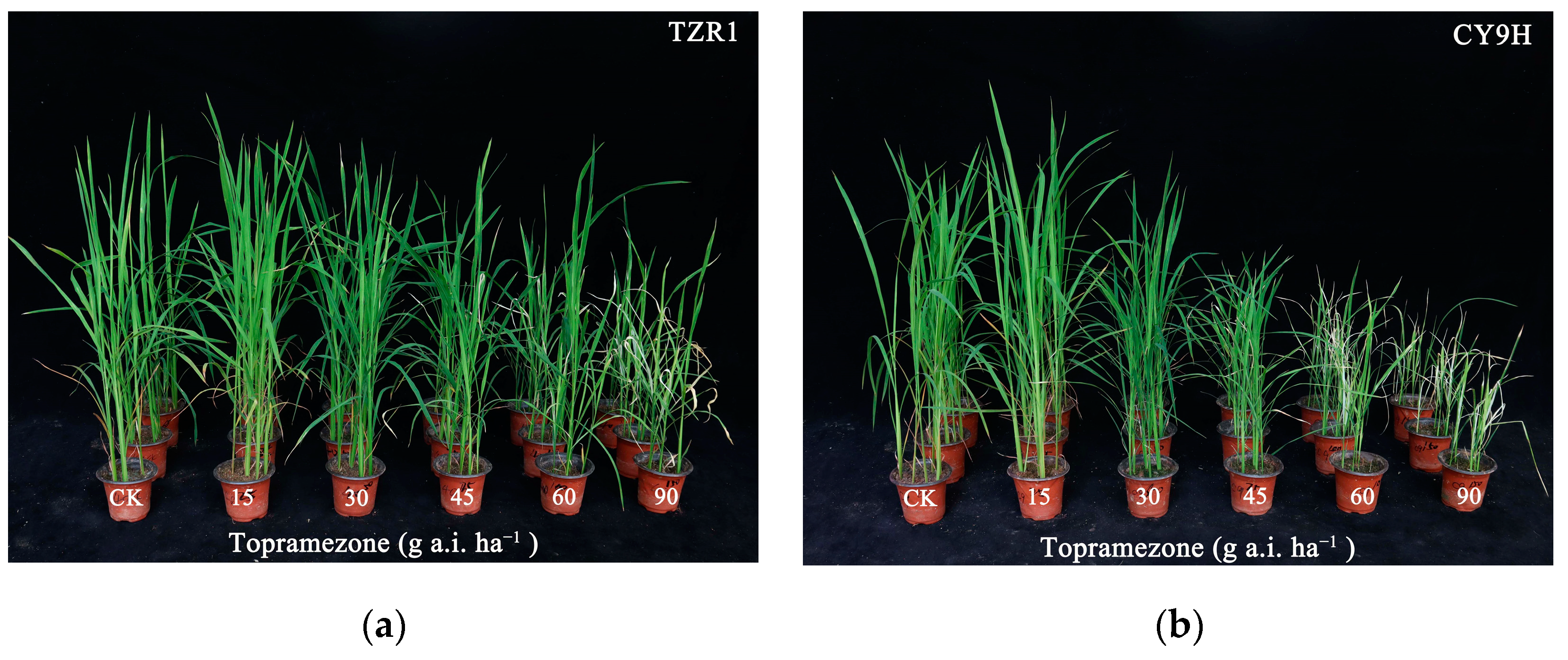

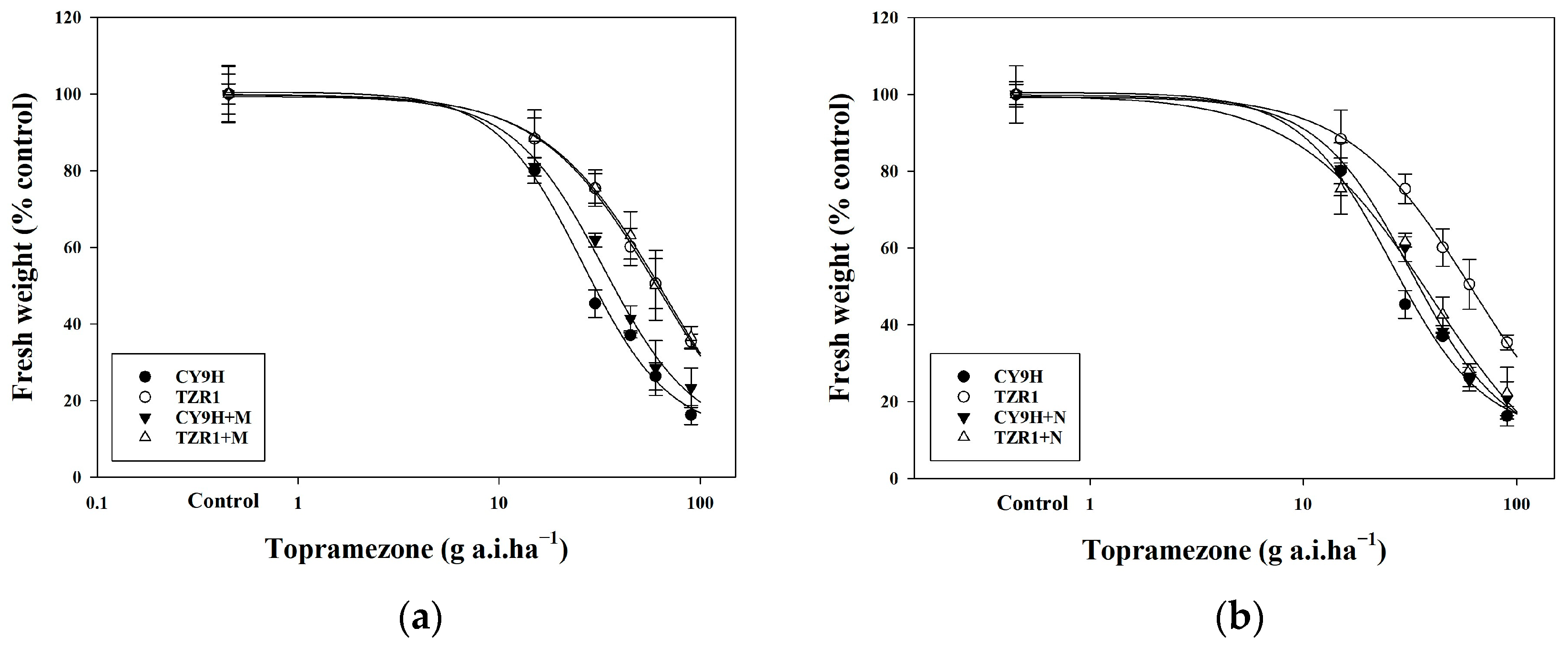
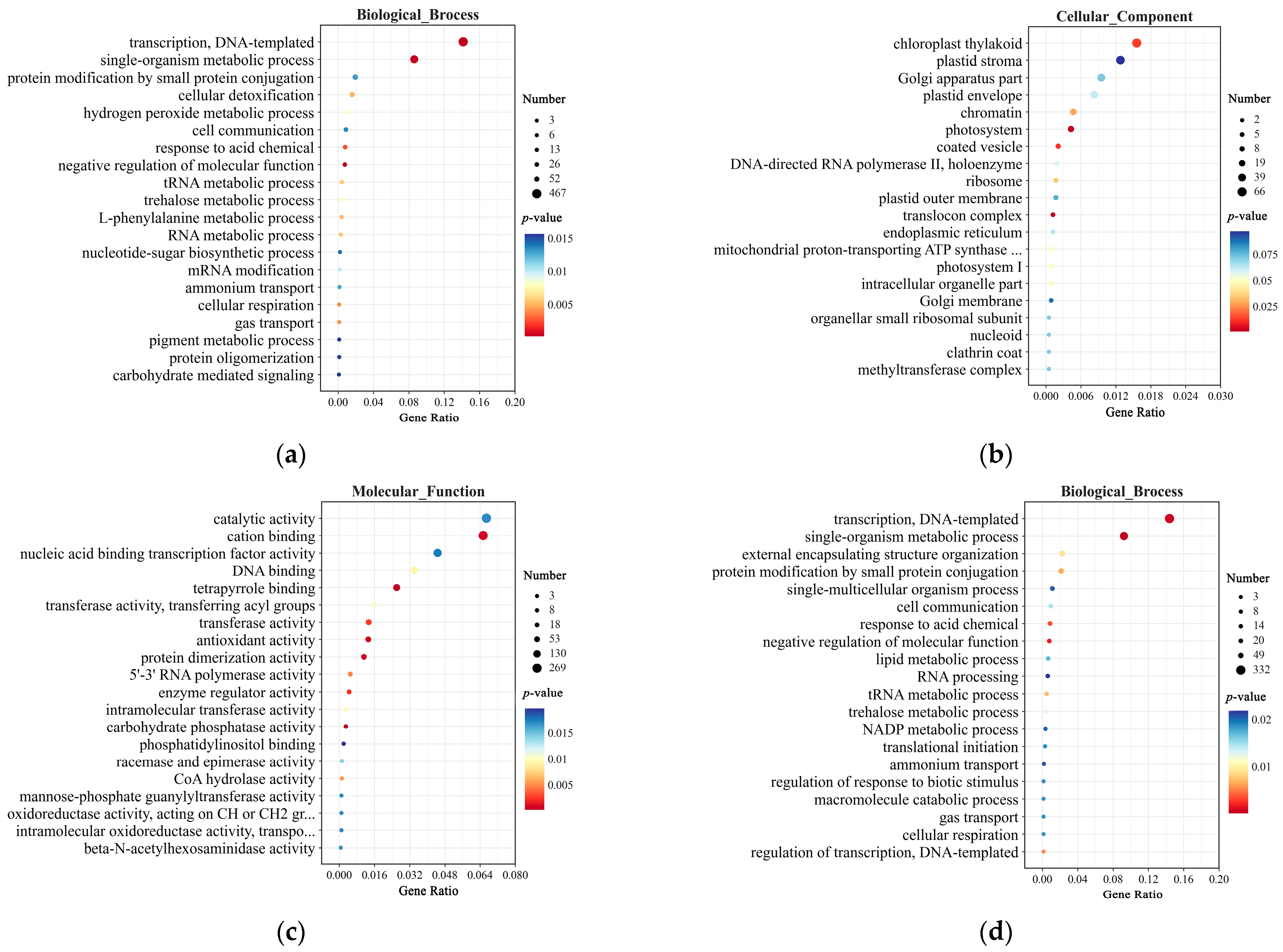
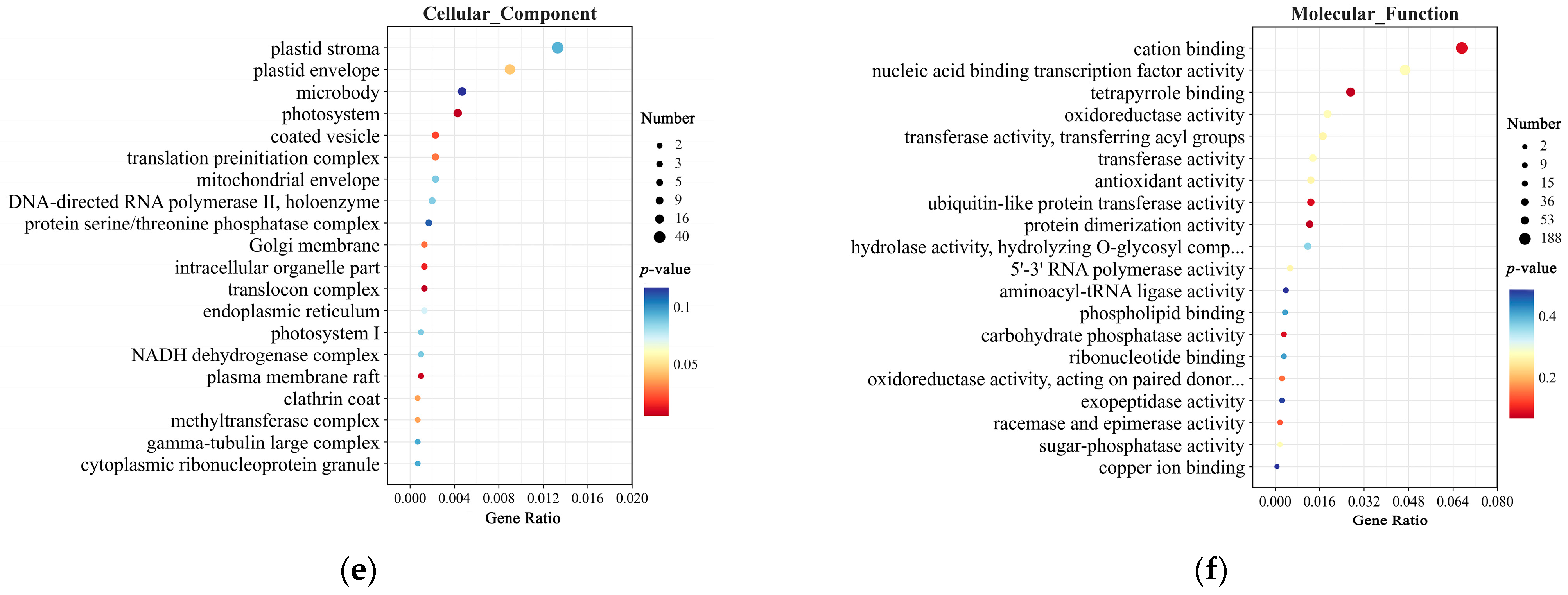
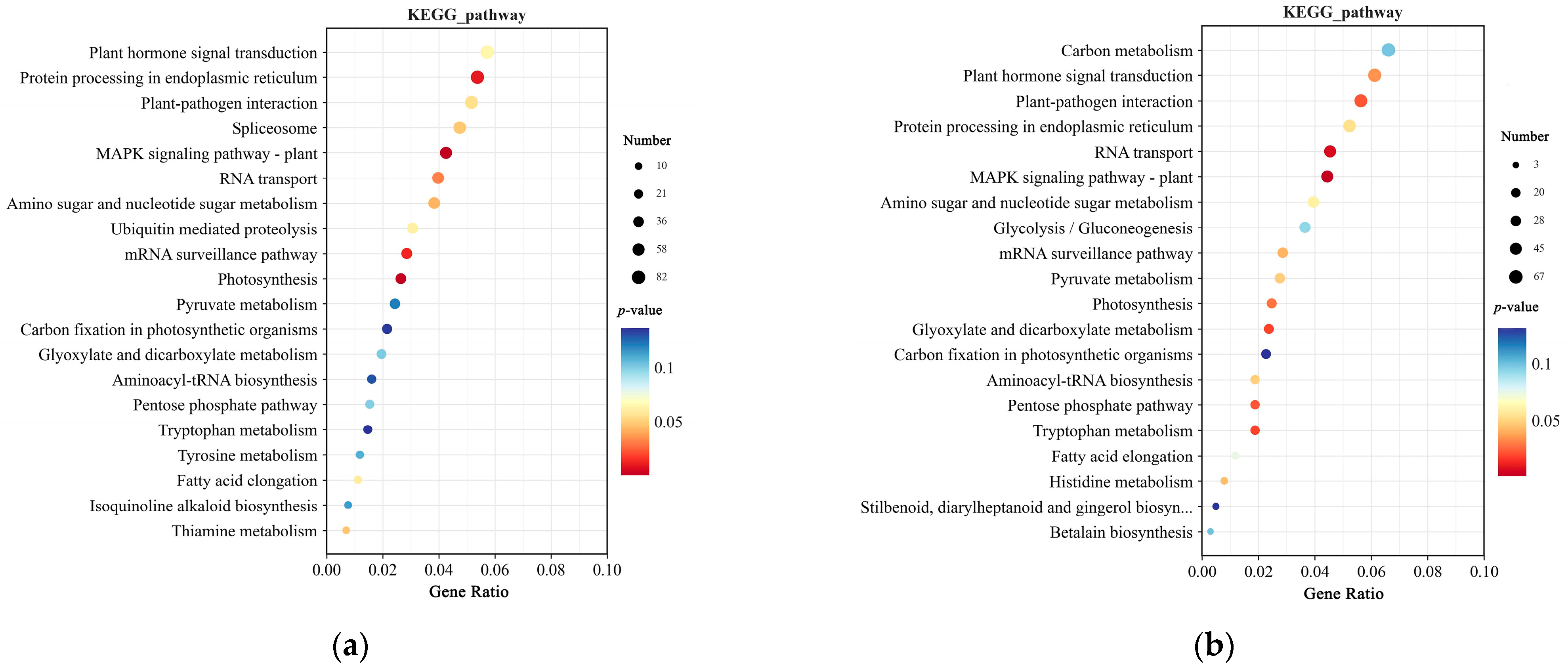
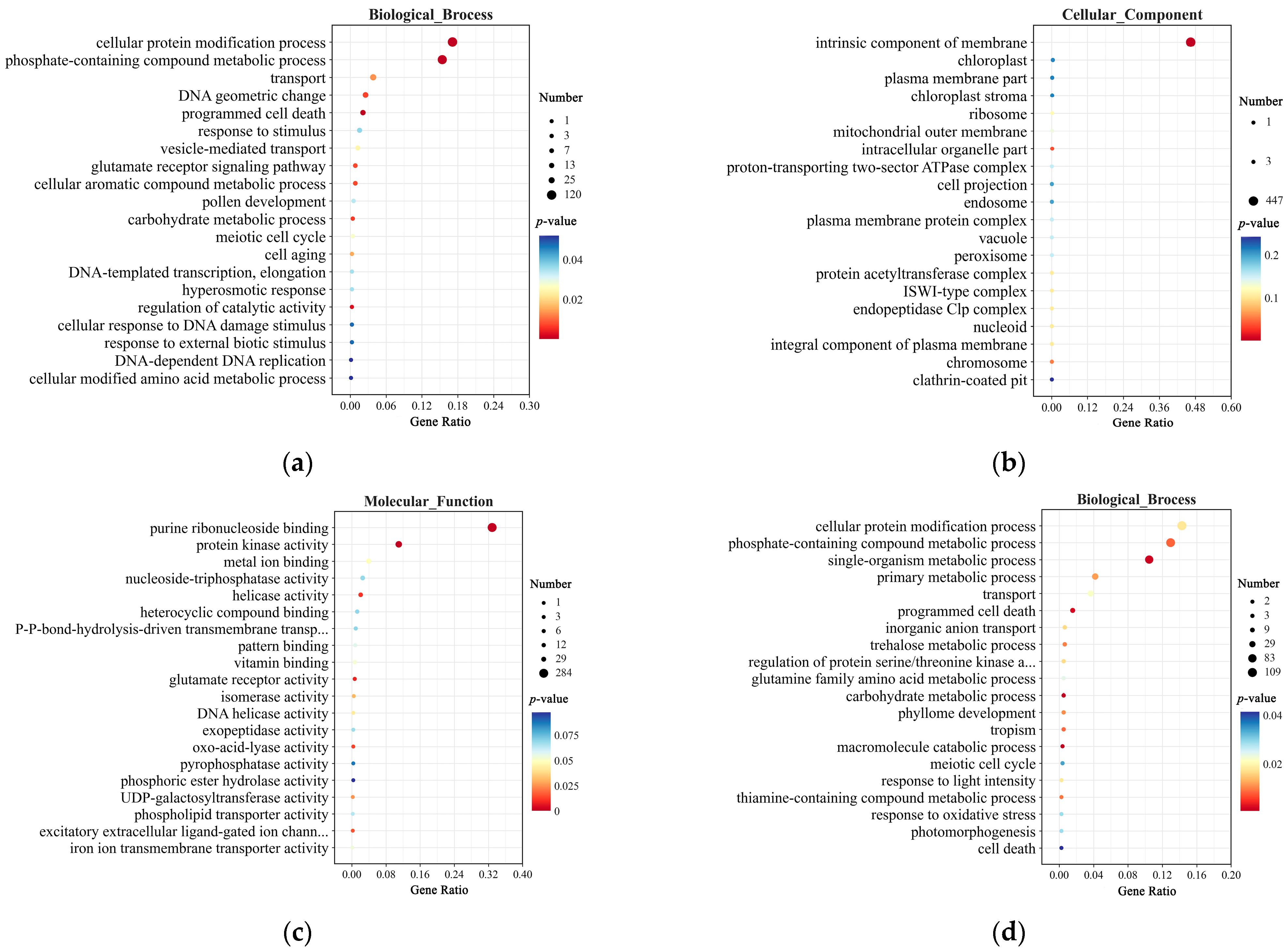
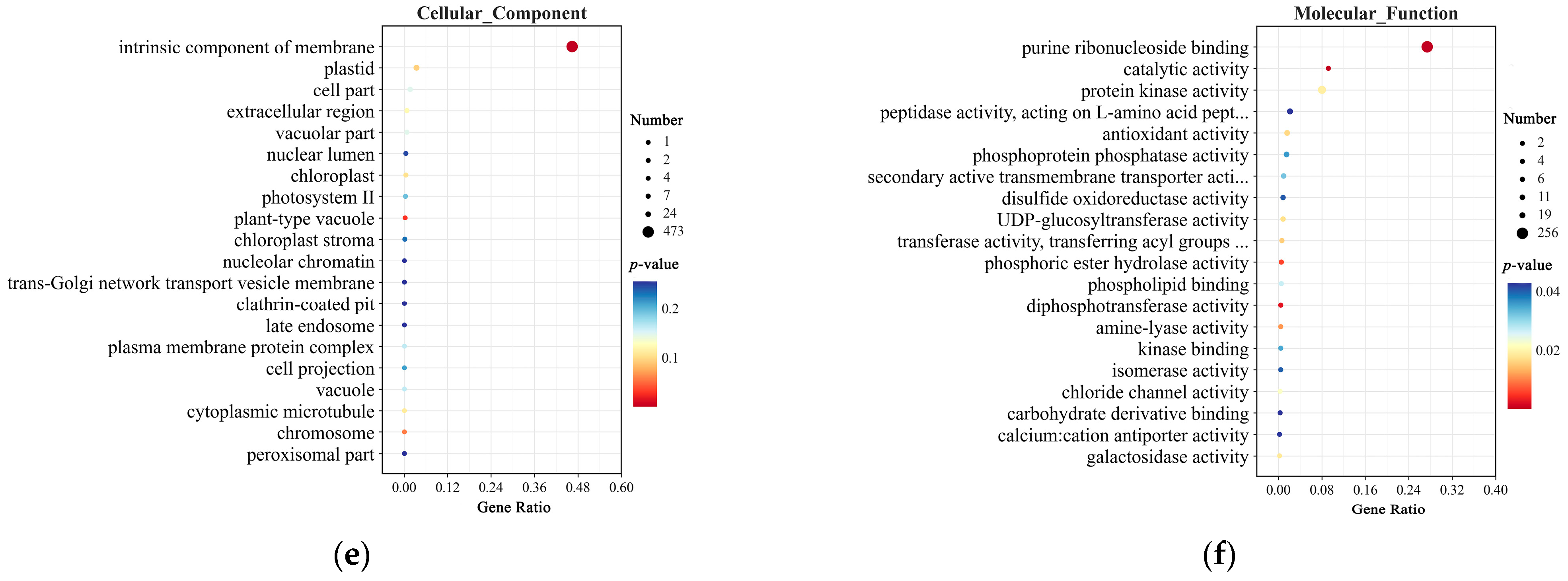


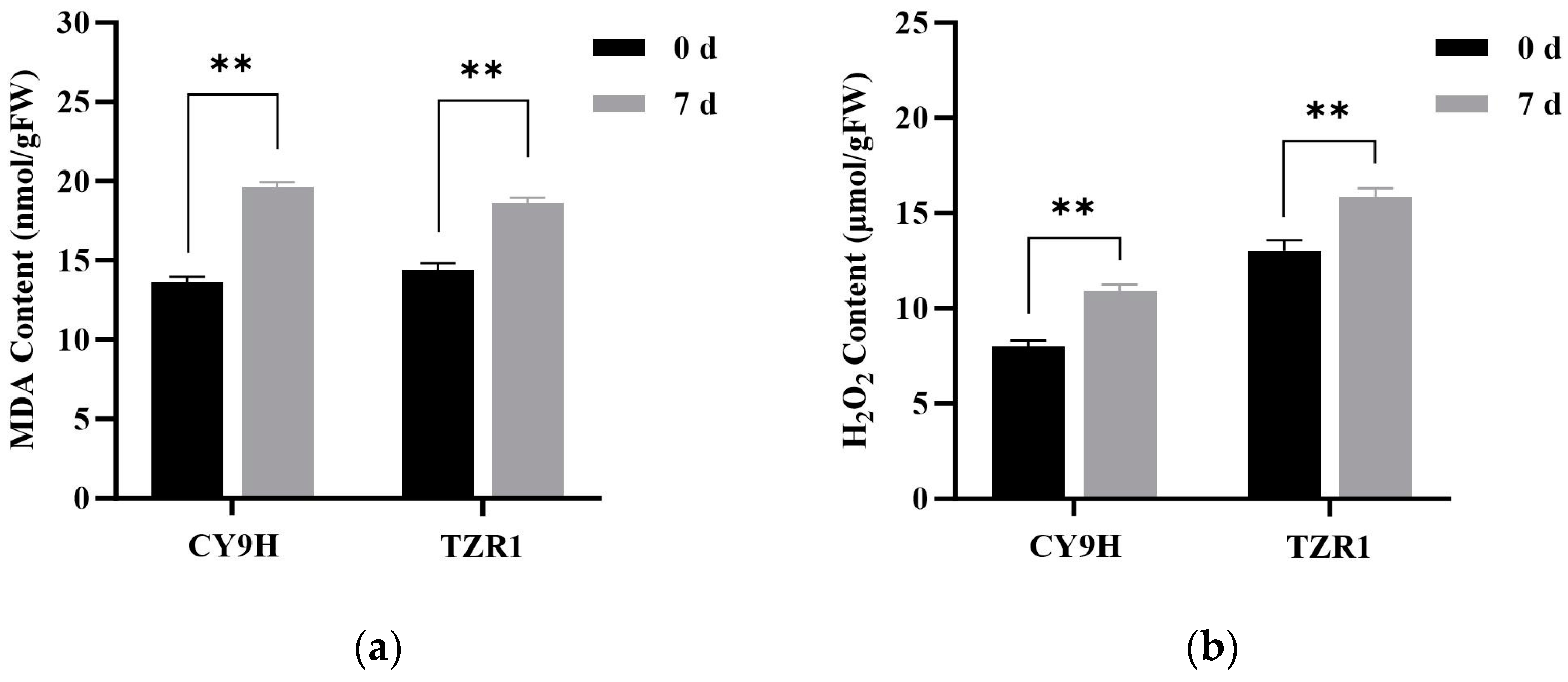

| Rice Line | Treatment | Slope ± SE | Chi-Square (X2) | df | p-Value | GR50 (95%CL) (g a.i. ha−1) # | RI § |
|---|---|---|---|---|---|---|---|
| CY9H | Topramezone | 3.761 ± 0.414 | 2.433 | 3 | 0.487 | 31.27 (27.10–35.36) b | 1.00 |
| Topramezone + Malathion | 3.644 ± 0.412 | 1.800 | 3 | 0.615 | 37.81 (33.15–42.76) b | 1.21 | |
| Topramezone + NBD-Cl | 3.828 ± 0.419 | 2.081 | 3 | 0.556 | 35.55 (31.21–40.02) b | 1.14 | |
| TZR1 | Topramezone | 3.440 ± 0.436 | 0.156 | 3 | 0.984 | 60.51 (52.93–71.51) a | 1.94 |
| Topramezone + Malathion | 3.418 ± 0.437 | 0.220 | 3 | 0.974 | 62.19 (54.27–73.94) a | 1.99 | |
| Topramezone + NBD-Cl | 3.321 ± 0.398 | 2.287 | 3 | 0.515 | 36.00 (31.09–41.12) b | 1.15 |
| DEGs | Function Annotation | Log2FC a | FC b | t-Test c |
|---|---|---|---|---|
| GSTs | OsGST4 | 1.48 | 2.74 | ** |
| OsGSTF1 | 5.37 | 6.75 | ** | |
| OsGSTU6-1 | 1.62 | 2.06 | * | |
| OsGSTU6-3 | 13.40 | 7.35 | ** | |
| OsGSTT3 | 9.29 | 2.40 | * | |
| UGTs | OsUGT73D1 | 2.90 | 2.93 | * |
| OsUGT75L6 | 1.79 | 3.71 | * | |
| ABC transporter | OsABCC8 | 1.33 | 3.50 | * |
| OsABCC10 | 3.72 | 20.44 | ** | |
| OsABCG11 | 2.32 | 19.76 | ** |
Disclaimer/Publisher’s Note: The statements, opinions and data contained in all publications are solely those of the individual author(s) and contributor(s) and not of MDPI and/or the editor(s). MDPI and/or the editor(s) disclaim responsibility for any injury to people or property resulting from any ideas, methods, instructions or products referred to in the content. |
© 2025 by the authors. Licensee MDPI, Basel, Switzerland. This article is an open access article distributed under the terms and conditions of the Creative Commons Attribution (CC BY) license (https://creativecommons.org/licenses/by/4.0/).
Share and Cite
Hu, S.; Luo, K.; Tang, T.; Ma, G.; Peng, Y.; Zhang, Y.; Liu, Y.; Pan, L.; Li, S. Characterization of a Topramezone-Resistant Rice Mutant TZR1: Insights into GST-Mediated Detoxification and Antioxidant Responses. Plants 2025, 14, 425. https://doi.org/10.3390/plants14030425
Hu S, Luo K, Tang T, Ma G, Peng Y, Zhang Y, Liu Y, Pan L, Li S. Characterization of a Topramezone-Resistant Rice Mutant TZR1: Insights into GST-Mediated Detoxification and Antioxidant Responses. Plants. 2025; 14(3):425. https://doi.org/10.3390/plants14030425
Chicago/Turabian StyleHu, Shiyuan, Kai Luo, Tao Tang, Guolan Ma, Yajun Peng, Yuzhu Zhang, Yang Liu, Lang Pan, and Sifu Li. 2025. "Characterization of a Topramezone-Resistant Rice Mutant TZR1: Insights into GST-Mediated Detoxification and Antioxidant Responses" Plants 14, no. 3: 425. https://doi.org/10.3390/plants14030425
APA StyleHu, S., Luo, K., Tang, T., Ma, G., Peng, Y., Zhang, Y., Liu, Y., Pan, L., & Li, S. (2025). Characterization of a Topramezone-Resistant Rice Mutant TZR1: Insights into GST-Mediated Detoxification and Antioxidant Responses. Plants, 14(3), 425. https://doi.org/10.3390/plants14030425






